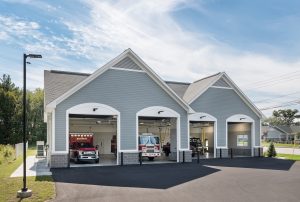BUILT-IN FUNCTIONALITY: Hudson, NH Fire Station
In Boston, Structure Tone is primarily known for its unparalleled expertise in commercial interior construction, from small upgrades to high-end renovations. But when the team expanded their services into New Hampshire in 2016, they knew it could open doors into new and different types of work, including public facilities and out-of-the-ground construction.

One of their first opportunities arose when the town of Hudson, New Hampshire needed a new fire station. The 7,800sf, brand new, design/build facility would help fill a gap in one end of town and would serve as a model station for future renovations.
“These kinds of projects are part of why we expanded into New Hampshire,” says Thomas Roy, Structure Tone account executive.”We have a team with decades of experience in new construction, and we knew this Hudson project was a great chance to show what we could do.”
All Systems Go
While the facility’s features are typical for a fire station, they aren’t typical of an average building—new construction or not. Common building elements like the foundation and the MEP systems are specifically designed for the needs of fire station equipment and processes. Structure Tone worked together with the architects from Harriman to fit those features into an attractive, functional town facility.
The concrete slab, for instance, is heavily reinforced to support the weight of four fire trucks and their water tanks. The HVAC system comprises a special ventilation system that allows the firefighters to run their daily tests and checks without opening the garage bays—a feature the crews particularly appreciate during the brutal New Hampshire winters.
“This vent system has a hose and collar that hooks directly onto a truck’s exhaust pipe,” says Tony Page, Structure Tone superintendent. “Air pressure holds the collar onto the pipe but if the truck gets a call, an exhaust pressure sensor releases the pressure on the collar and it pops right off as the truck pulls away.”
The mechanical system has some similarly unique features. Most heavy trucks use a compressed air brake system in which the truck must idle before moving to let the pressure build up behind the brakes. Fire trucks, however, must be on the move as soon as they are called to an emergency. To keep them ready to roll at all times, the station’s mechanical room hosts a large commercial air compressor with hoses that plug into each of the trucks. This system pre-pressurizes the air brakes so that when the fire house gets a call, the crew can simply pop off the hoses and go.
Client First
 While those extra elements added some construction challenges for the team, the biggest hurdle, says Page, was the weather.
While those extra elements added some construction challenges for the team, the biggest hurdle, says Page, was the weather.
“We worked really hard with our subs to keep everything on track to avoid the cold of mid-winter,” he says. “But we did work through cold and snow, putting things on hold for only two days when the weather just simply prohibited doing anything.”
The new James A. Taylor Memorial Station was officially opened last July, and hundreds of townspeople came out to celebrate the opening and honor the fallen firefighter for which it was named. Since then, the Structure Tone team has continued to keep in touch with the fire department to ensure the station was just as they envisioned.
“The firefighters basically live there several days a week, so we asked them to keep track of what they think needs tweaking and we address it,’’ says Page. “We did things the STOBG Way—whatever it takes to make the client happy, that’s what we do.”
